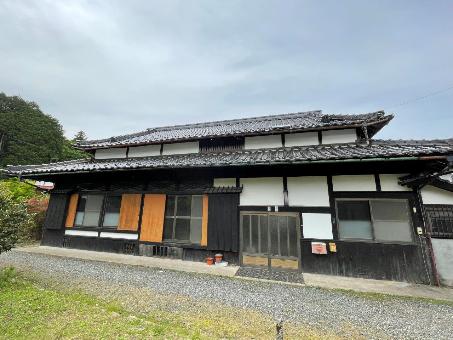
 Verify availability
Verify availabilityAdd to lists:✕

It is along the prefectural road and has good access. Properties in a quiet environment.県道沿いであり、アクセスは良好。静穏な環境の物件。
| Security deposit:敷金 | Deposit敷金 |
|---|---|
| Key money:礼金 | Key money礼金 |
| Land:土地面積 | 470 m² |
| Building:建物面積 | 111 m² |
| Structure:構造 | Building 111.38m2, Land 470.85m2 (142.43 pyeong)建物111.38m2、土地470.85m2(142.43坪) |
| Built in:建築年 | 1978 |

Spacious old house property. It is close to the prefectural road and has good access.広々とした古民家物件。県道に近く、アクセスは良好。
| Land:土地面積 | 818 m² |
|---|---|
| Building:建物面積 | 113 m² |
| Scale:建物規模 | Building: 113.52 m2, land: 818.84 m2 (247.69 tsubo)建物113.52m2、土地818.84m2(247.69坪) |
| Structure:構造 | Old folk house古民家 |
| Built in:建築年 | 1916 |

A spacious old house with farmland. Garage included. Located along National Route 56, it is easily accessible. About 4 minutes (3.1km) by car from Seiyo-Uwa Interchange.広い間取りを備えた、農地付きの古民家物件。ガレージ付き。国道56号線沿いにあり、アクセスは良好です。西予宇和インターチェンジから車で約4分(3.1km)。
| Land:土地面積 | 308 m² |
|---|---|
| Building:建物面積 | 162 m² |
| Scale:建物規模 | 8SK8SK |
| Structure:構造 | Taisho 5大正5年 |
| Built in:建築年 | 1916 |

It is large enough for a two-generation family to live in. It is located on the corner of a quiet residential complex, on the riverside, and close to national and prefectural roads, with good access.2世帯家族でも暮らせます。閑静な住宅団地の角地、リバーサイド、国道・県道に近く、アクセスは良好です。
| Land:土地面積 | 437 m² |
|---|---|
| Building:建物面積 | 157 m² |
| Structure:構造 | Building 157.36m2, land 436.61m2 (132.07 tsubo)建物157.36m2、土地436.61m2(132.07坪) |
| Built in:建築年 | 1991 |

It is equipped with living facilities on the upper and lower floors, and can also be used as a two-family house. It is close to the center of the city and has very good access.上下階に居住設備を備えており、二世帯住宅としても可。市街地の中心に近く、アクセスも非常に良好です。
| Land:土地面積 | 178 m² |
|---|---|
| Building:建物面積 | 378 m² |
| Structure:構造 | Wooden木造 |
| Built in:建築年 | 1972 |

It is close to the city center and has good access. It is about 6 minutes by car from Seiyo-Uwa Interchange. The station and junior high school are within a 10-minute walk. Elementary schools and certified children's kindergartens are within a 5-minute walk!市街地に近く、アクセスは良好です。西予宇和インターチェンジから車で約6分。駅・中学校までは徒歩10分圏内。小学校・認定こども園までは徒歩5分圏内!
| Land:土地面積 | 399 m² |
|---|---|
| Building:建物面積 | 54 m² |
| Scale:建物規模 | 54.98m254.98m2 |
| Structure:構造 | Wooden木造 |
| Built in:建築年 | 1973 |

This is a detached house located close to the sea, with all facilities in good condition. The land is warm and quiet.海に近く、設備等状態は良好な一戸建て住宅です。温暖で静穏な土地環境。
| Land:土地面積 | 251 m² |
|---|---|
| Building:建物面積 | 58 m² |
| Scale:建物規模 | Building: 58.09 m2, land: 251.00 m2 (75.92 tsubo)建物58.09m2、土地251.00m2(75.92坪) |
| Structure:構造 | 1985昭和60年 |
| Built in:建築年 | 1985 |

Japan is an enticing destination for those looking to immigrate and start a new life. It is a country that seamlessly blends rich tradition with cutting-edge modernity. One of the key factors that make Japan so attractive to prospective immigrants is the housing availability. While Japan's bustling metropolises like Tokyo, Osaka, and Kyoto offer a wide range of housing options, from modern apartments to traditional machiya, the country also faces a unique issue: a surplus of vacant houses, especially in rural areas. This provides an intriguing opportunity for immigrants to potentially acquire properties at reasonable prices, often at a fraction of what one might pay in major cities.
Japan's real estate market is diverse and can cater to various budgets. While cities like Tokyo tend to be on the higher end of the spectrum, there are still affordable options to be found in the suburbs and smaller towns. This inclusivity in housing costs allows immigrants to select a location that suits their financial circumstances.
AllAkiyas.com puts at your disposition thousands of Japanese real estate listings of properties available for sale or rent. Our extensive listings include detached houses, townhouses, apartments, commercial spaces, and vacant lots. We place a special focus on traditional vacant houses, known as akiya (or kominka in rural areas), and traditional townhouses, or machiya. You can easily search for properties across all of Japan's prefectures using your specific criteria.